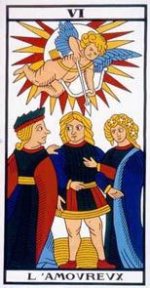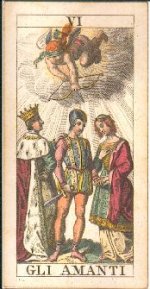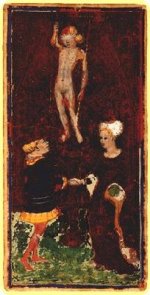exoteric and esoteric
While I hope not to offend or insult anyone, as that is not my purpose, I suppose offense is inevitable whenever we take a firm stand on any subject, especially one as volatile as tarot. The subject of trump VI, I think, begs us once again to ask what exactly we are looking at when we examine this singular pack of cards. Is there a system of esoteric knowledge embedded in the tarot pack? If so, was it deliberately implanted by the originators of the early Italian and French decks? Or is it simply a card game, one of whose components circumstantially contains some symbolic pictures, the subject matter of which follows no particular pattern or scheme?
Looking through the "decks" board on this forum earlier today, I ran across a thread in which people were ooing and ahing over a new tarot called "I Am One." Keying up the deck's web page, I found some modern-looking paintings by a modestly talented artist, along with a description of the deck reading in part:
"The 'I Am ONE' Tarot deck is a game of cards based on ancient school of "Tarot" that was last used in Egypt during the late 18th dynasty. The school of Tarot was designed for royal family members only, in order to prepare kings and queens for their destiny where they will have to demonstrate the model of a perfect human being.
"The Egyptian school of tarot was adopted at a later time by the Hebrews and their leader Moses, a royal master of Tarot. His intention to bring this method of schooling unto the many people instead of keeping it in the Egyptian palace, was the first establishment of Hebrew esoteric knowledge based on the 22 Hebrew alphabetic letters"
I have to confess that I'm at a total loss as to why people keep spreading this kind of nonsense. In his curmudgeonly and somewhat abusive introduction to the "Pictorial Key..." in 1909, A.E. Waite noted that occult histories of tarot "have few gifts of refreshment to heal the lacerations which they inflict on the logical understanding," adding that "the wrong history has been given in every published work which so far has dealt with (tarot)."
He concluded that the perpetuation of pseudo-histories based on fantasies "has continued and, within the charmed circle of the occult sciences, still passes from mouth to mouth -- there is no excuse for this." If there was no excuse for it in 1909, what can be said of it today? I can only judge, somewhat reluctantly, that the perpetuation of this sort of faux-scholarship invalidates any worth that a deck attached to it might have otherwise had.
Moving on to a more serious and coherent discussion of the meaning of the cards, we first encounter those who believe that the entire 78-card deck was conceived as a discrete vehicle for the transmission of one or another esoteric systems. Such an attitude is thoroughly ahistorical, as evidence too abundant to mention shows that the 52-card pack antedated tarot. In other words, such theories have absolutely no credibility.
That leaves the trumps, which are obviously symbolic pictures, and the question: is there a method here? a system? a plan? After many years of considering this matter, I've come to the conclusion that there isn't. The contrasting interpretations of trump VI given above clearly show the contrast between the esoteric and exoteric approaches to the cards, and I have already given my own exoteric interpretation, that this picture shows, or was originally meant to show, a representation of the emotion of romantic love, and to a lesser extent marriage, and nothing more.
The earliest version of trump VI we know of, the one in the Visconti di Modrone (Cary-Yale) pack, shows the man and woman holding hands in front of a pavilion, Cupid floating above them, and a little dog at their feet. Heraldic emblems of both the Visconti and Sforza families appear on this card (and throughout the deck), and it might memorialize the 1441 wedding of Francesco Sforza to Bianca Maria Visconti. Stuart Kaplan has proposed that the deck was a wedding present (Dummett, "The Visconti-Sforza Tarot Cards," p. 14). This would make the Lovers card in this pack very similar to the famous wedding portrait painted by Jan Van Eyck in 1434, in which he portrays himself, his pregnant bride, and a toy dog, a universal symbol of fidelity, standing at their feet.
I believe this card more than any other perfectly illustrates the straightforward and unmysterious nature (just my opinion) of the tarot trumps.
(catboxer)




